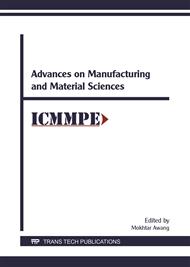[1]
Available at www. unuftp. is/static/fellows/document/samsuddin03prf. pdf.
Google Scholar
[2]
Market Development, CI on Composites, SPI Composites Institute, New York, NY, Aug/Sep 1994, pp.10-11.
Google Scholar
[3]
Beckwith SW, Hyland CR. Resin transfer molding: a decade of technology advances. SAMPEJ 1998; 34(6): 7–19.
Google Scholar
[4]
Potter K. Resin transfer moulding. London: Chapman&Hall; 1997. ISBN 0-412-72570-3.
Google Scholar
[5]
Benjamin WP, Beckwith SW. Resin transfer moulding. SAMPE Monograph 3. Covina (CA); 1999. ISBN 0-938-99483-2.
Google Scholar
[6]
Information at http: /www. seemanncomposites. com/index. php?option=com_content &view=article&id=26&Itemid=26.
Google Scholar
[7]
Williams CD, Summerscales J, Grove SM. Resin infusion under flexible tooling (RIFT): a review. Compos Part A Appl Sci Manuf 1996 July; 27A(7): 517–524.
DOI: 10.1016/1359-835x(96)00008-5
Google Scholar
[8]
Beckwith SW. Resin infusion technology; (a) Part 1—industry highlights. SAMPE J 2007; 43(1): 61; (b) Part 2—process definitions and industry variations. SAMPE J 2007; 43(3): 46; (c) Part 3—a detailed overview of RTM and VIP infusion processing. SAMPE J 2007; 43(4): 6, 66–70.
Google Scholar
[9]
Cripps D, Searle TJ, Summerscales J. Open mould techniques for thermoset composites. In: Talreja R, Månson JA, editors. Comprehensive composite materials encyclopedia. Volume 2, Polymer matrix composites. Oxford: ElsevierScience; 2000. p.737.
DOI: 10.1016/b0-08-042993-9/00188-1
Google Scholar
[10]
M.S. Koefoed, Modeling and Simulation of the VARTM Process for Wind Turbine Blades, Industrial Ph.D. Dissertation, Aalborg University, (2003).
Google Scholar
[11]
N.C. Correia, F. Robitaille, A.C. Long, C.D. Rudd, P. Simacek, S.G. Advani, Use of Resin Transfer Moulding Simulation to Predict Flow, Saturation and Compaction in the VARTM Process, Journal of Fluids Engineering ASME 126 (2004) 210-215.
DOI: 10.1115/1.1669032
Google Scholar
[12]
Ragondet A. Experimental Characterization of the Vacuum Infusion Process. PhD thesis, 2005, University of Nottingham.
Google Scholar
[13]
Hoebergen A, van Herpt E, Labordus M. The manufacture of large parts using the vacuum injection technique.
Google Scholar
[14]
Information at http: /www. fibreglast. com/product/vacuum-infusion-brochure.
Google Scholar
[15]
Kim, S. Y., Shim, C. S., Sturtevant, C., & Song, H. C. (2014).
Google Scholar
[16]
Kim, D., Hennigan, D. J., & Beavers, K. D. (2010).
Google Scholar
[17]
Kao-Walter, S., Mfoumou, E., & Ndikontar, M. (2012). Mechanical Properties and Life-Cycle Sustainability Aspects of Natural Fibre. In Advanced Materials Research (Vol. 347, pp.1887-1893). Trans Tech Publications.
DOI: 10.4028/www.scientific.net/amr.347-353.1887
Google Scholar
[18]
Reddy, N., & Yang, Y. (2005). Biofibers from agricultural byproducts for industrial applications. TRENDS in Biotechnology, 23(1), 22-27.
DOI: 10.1016/j.tibtech.2004.11.002
Google Scholar
[19]
C.S. Vavrina, K. Armbrester, A. Mireia and M. Pena: Coconut Coir as an Alternative to Peat Media for Vegetable Transplant Production. University of Florida, Southwest Florida Research and Education Centre P.O. Drawer 5127, Immokalee, FL 33934.
Google Scholar
[20]
Rajan, A., Senan, R. C., Pavithran, C., & Abraham, T. E. (2005). Biosoftening of coir fiber using selected microorganisms. Bioprocess and biosystems engineering, 28(3), 165-173.
DOI: 10.1007/s00449-005-0023-2
Google Scholar
[21]
Information at http: /www. 3dcore. com/en/downloads/3D_Flyer_Take_less_en. pdf.
Google Scholar
[22]
Information at http: /www. 3d-core. com/en/3d-core/3d-core-info. html.
Google Scholar
[23]
Information at http: /www. easycomposites. co. uk/#!/core-materials/closed-cell-foam-and 3dcore/easycell75g-infusion-grooved-closed-cell-pvc-foam-core. html.
Google Scholar
[24]
Information at http: /www. easycomposites. co. uk/#!/core-materials/closed-cell-foam-and-3dcore/easycell75g-infusion-grooved-closed-cell-pvc-foam-core. html.
Google Scholar
[25]
Information at http: /www. westsystem. com/ss/assets/Upload/Ew21chopped. pdf.
Google Scholar
[26]
Information at http: /textinfo. files. wordpress. com/2012/01/needle-punching1. pdf.
Google Scholar


